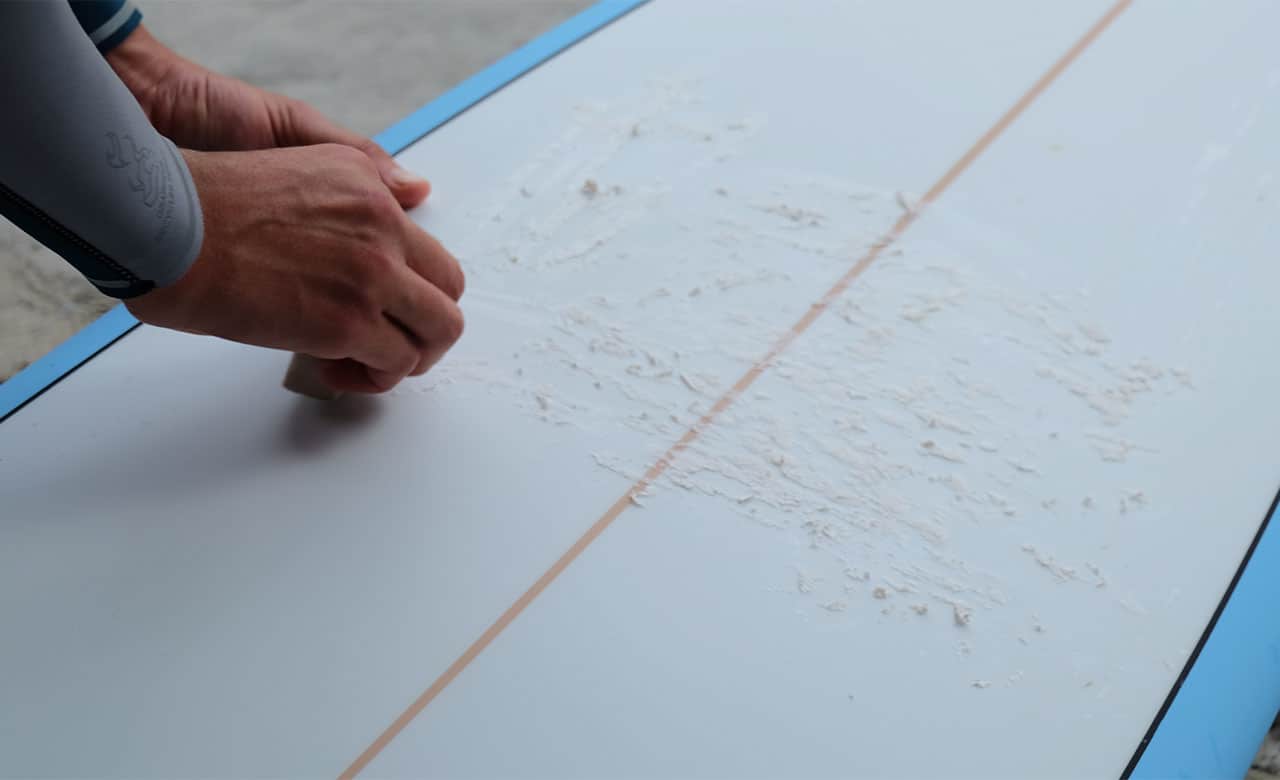As a beginner, transferring from soft tops to a hard-top PU-surfboard will require some knowledge about surf wax. In this quick guide, we will teach you how to wax a new surfboard. This information will be helpful for beginners and a good refresher for more experienced surfers.
Epoxy and PU-surfboards have a hard and slippery surface compared to soft-tops, and that’s why surf wax is needed. The sticky and tacky surf wax creates the necessary grip to keep our feet planted on the surfboard.
Many surfers use a traction pad at the tail of the surfboard to provide extra grip for their back foot, and then they wax up the rest of the surfboard.
Clean your surfboard
First thing first, let’s clean the surfboard. Even though it’s a new board, we want to make sure that we get rid of any dust that might be on there. It will help the surf wax stick better. For this process, you can simply use some glass cleaner spray and a soft cloth.
Choose the right surf wax type
Next up, we need to pick the right wax type for the surfboard. There are several different surf wax types to choose from. Furthermore, we need to apply two kinds of wax – A basecoat and a topcoat.
The basecoat is a standard wax that makes a good and solid base. Your basecoat wax should be harder than your topcoat as it’s meant to be a primary layer that your topcoat can stick to. The basecoat will be a one-time application that can easily be freshened up with a new layer of topcoat when the board starts to lose its traction.
The topcoat wax is determined by the water temperature you are surfing in. The rule is simple, the warmer the water the harder the surf wax. In the box below, you can find the best wax type for your local surf spot.
| Surf Wax Type | Water Temperature |
|---|---|
| Base Coat | Applied in all temperatures |
| Cold | 58°F & Below (14°C & Below) |
| Cool | 58°F - 68°F (14°C -20°C) |
| Warm | 68°F - 75°F (20°C -24°C) |
| Tropical | 75°F & Above (24°C & Above) |
Waxing your New Surfboard:
- 5 easy steps
Finally, we need to apply the surf wax. There are many ways to wax a surfboard for the first time. This is just an example of one of those:
- Apply a thin layer of base coat. Do not rub the wax hard, and do not force it. Keep the layer light and smooth.
- Grab your bar of top coat surf wax and start from your board’s bottom area, typically just above your tail pad. Make a wax line with an edge from your rail to your stringer at a 45-degree angle going up. Do this all the way up from your one rail before repeating the process from your other rail.
- Once this is done, repeat the same process. This time make the line from your rail to the stringer going down at 45 degrees. These lines will criss-cross over the first set of lines making a grid pattern.
- Always remember to wax lightly. If you are a keen surfer, you will wax your board so many times, and more and more wax will go onto the deck of your board, so no need to rush it.
- Once you have the grid pattern, use the edge of your surfboard wax and make a few tiny circles within the grid pattern. These will make humps for you, and you’re ready to go.
Surfboard waxing tips:
1. Create wax bumps
After applying your topcoat layer, your board should have sufficient raised bumps. If this is not the case, your surf wax hasn’t been applied properly.
2. Don’t Press Too Hard
When applying your surf wax it’s important to use the right pressure. Pressing too hard can lead to over-application, while a too soft pressure doesn’t allow you to form a strong foundation.
We recommend using medium pressure on your board when applying the surf wax.
3. Only apply wax where it's needed
You only need to apply surf wax in the area where your feet are. It means that the top portion of the surfboard does not necessarily need to be waxed entirely.
However, on longboards where you change your surf stance, it can be necessary to wax your board all the way to the nose. The same applies on a shortboard if you are doing a lot of aerial maneuvers, where you need to stick the landing.
4. Apply the right amount
Excessive use of surf wax can actually make your surfboard more slippery, so it’s important to know how much surf wax you need.
A useful rule of thumb is:
- About half a bar for a shortboard under 7.
- About 3/4 of a bar for a surfboard in the min-mal range (between 7 and 9 foot).
- At least a whole surf wax bar for a longboard over 9 foot.
5. How often should you apply new surf wax?
We recommend that you remove all surf wax from your board every two-three months. You will start to feel when the surfboard is losing its grip. Make sure you know how to remove old surfboard wax.
In terms of topcoats, apply a new thin layer before every surf session to “freshen up” your board and keep the necessary traction.
6. Be aware of temperature changes
As we learned, the temperature affects the surf wax. Be aware of temperature changes in the water, and make sure to adjust your topcoat layer accordingly.
7. No need to wax a foamie
Foam surfboards don’t require wax since they have a soft top. However, some surfers do wax their foam surfboard with a thin layer of topcoat, because they prefer the familiar feeling and want to add a bit of extra grip.


